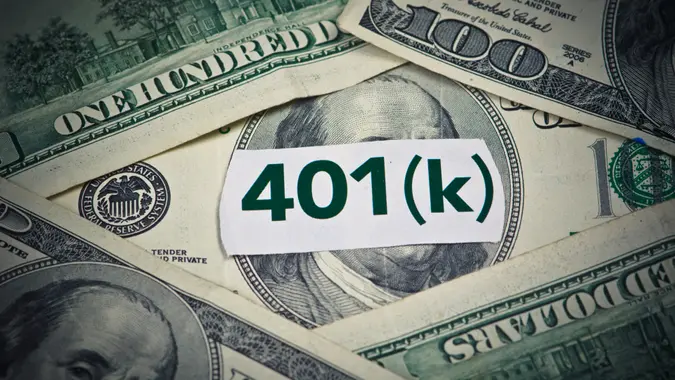What Is the Average 401(k) Return?

Commitment to Our Readers
GOBankingRates' editorial team is committed to bringing you unbiased reviews and information. We use data-driven methodologies to evaluate financial products and services - our reviews and ratings are not influenced by advertisers. You can read more about our editorial guidelines and our products and services review methodology.

20 Years
Helping You Live Richer

Reviewed
by Experts

Trusted by
Millions of Readers
When you think about your 401(k), one of the first things that probably comes to mind is how much it’s actually growing. On average, the typical 401k return lands somewhere between 5% and 8% a year. That’s a useful benchmark, but it doesn’t tell the whole story. Your actual return depends on the mix of investments you choose, the fees you’re paying and whether you’re taking full advantage of an employer match.
Knowing what the average rate of return on a 401(k) looks like helps set realistic expectations — but more importantly, it shows you where you can take control. Consistent contributions, smart fund choices and patience through market ups and downs can make a huge difference in your long-term balance.
Average 401(k) Balances by Age
To put those returns in context, it helps to look at what people actually have saved. According to Vanguard’s most recent data, the average 401(k) balance for people ages 65 and up is about $279,997, while the median balance is just $87,725. That median tells us half of retirees have less than that saved.
Other studies confirm this savings gap: the Federal Reserve reports that nearly 25% of non-retired adults have no retirement savings at all. These numbers highlight why consistent contributions are key and why maximizing even small boosts to your savings rate can pay off over time.
How Contributing an Extra 1% Impacts Your 401(k)
One of the easiest ways to boost your future returns is to slowly increase your contribution rate. For example:
- Let’s say Brad is 30 years old, earns $60,000 a year and contributes 10% of his salary to his 401(k). His employer matches 50% up to 6% and his investments earn a 7% average annual return.
- By age 65, Brad would have around $820,000 saved.
- If he increased his contribution to 11%, his balance would jump to roughly $900,000.
That extra 1% contribution — just $50 a month — adds nearly $80,000 to his retirement savings. Small changes really do add up.
What Americans Have Saved in Their 401(k) Plans
Top Factors That Affect Your 401(k) Growth
The “average 401(k) return” is just that — an average. Your personal results can vary based on several factors:
- Fees: Depending on your plan, you might pay between 0.2% and 5% in fees. Experts at Yale University found that fees above 1% can significantly erode long-term growth.
- Asset allocation: A 60/40 mix of stocks and bonds is common, but target-date funds automatically shift toward conservative investments as you near retirement.
- Contributions: The more you contribute — and the sooner you start — the more time compounding has to work in your favor.
- Market behavior: Your returns rise and fall with the stock market. For perspective, the S&P 500 delivered an average annual return of about 10.3% from 2003 to 2023.
Why Comparing to the “Average” Can Be Misleading
It’s tempting to measure your 401(k) against averages, but that can lead to unrealistic expectations. Those averages assume:
- Steady contributions
- No early withdrawals
- A well-diversified portfolio
Real life is messier. Market downturns, job changes or tapping your account early can reduce returns. Instead of fixating on averages, focus on:
- Making consistent contributions
- Taking full advantage of employer matches
- Avoiding early withdrawals and penalties
How to Maximize Your 401(k) Returns
If you’re not happy with your current returns, here are a few practical steps to improve them:
- Maximize contributions: Try to contribute at least enough to get the full employer match. If possible, increase your savings rate by 1% each year.
- Rebalance your portfolio: Review your investments annually to ensure you’re not taking on too much — or too little — risk.
- Choose low-fee funds: High fees eat into your returns. Index funds and ETFs often cost far less than actively managed funds.
- Stay consistent: Riding out market dips instead of pulling money out is one of the best ways to let compounding work.
401(k) vs. Other Investment Options
Here’s how 401(k)s stack up against some popular alternatives:
| Option | None unless in a tax-advantaged acct | Tax Benefits | Flexibility |
|---|---|---|---|
| 401(k) | 5% to 8% | Pre-tax, tax-deferred | Limited until 59½ |
| Roth IRA | 5% to 8% | Post-tax, tax-free growth | Withdraw contributions anytime |
| Traditional IRA | 5% to 8% | Pre-tax, tax-deferred | Similar to 401(k) |
| Taxable Account | Varies | None | Full access anytime |
| S&P 500 (avg) | 10.3% (2003-23) | None unless in a tax-advantaged account | Full access anytime |
Key Takeaways
- The average 401(k) return is 5% to 8% per year, but your actual growth depends on contributions, fees and asset allocation.
- Even a 1% increase in contributions can add tens of thousands of dollars to your retirement balance.
- Comparing your return to “averages” can be misleading. Focus instead on consistency and maximizing your match.
- A 401(k) may not outperform the S&P 500, but its tax benefits, employer match and long-term structure make it a cornerstone of retirement savings.
Final Take to GO
At the end of the day, the average 401(k) return gives you a benchmark, but it shouldn’t define your strategy. What matters most is consistency; contributing regularly, minimizing fees and letting compound growth work over time.
If you’re looking for ways to boost your savings further, check out our guide to high-yield savings accounts and IRA contribution limits to round out your retirement plan.
FAQs About 401(k) Returns
Here are answers to some of the most frequently asked questions about the average 401(k) return.- What is the average rate of return on a 401(k)
- Typically between 5% and 8%, though long-term stock market returns are closer to 10%.
- How often should I rebalance my 401(k)?
- At least once a year -- or anytime your asset allocation drifts significantly.
- Is it better to max out my 401(k) or pay down debt?
- It depends on your situation. High-interest debt should usually come first, but don’t leave an employer match on the table.
- Can I lose money in a 401(k)?
- Yes. Your balance will fluctuate with the market, but staying invested long-term typically smooths out downturns.
- How much should I contribute?
- Financial planners often recommend saving 15% of your income, including employer match, if possible.
Information is accurate as of Aug. 19, 2025.
 Written by
Written by  Edited by
Edited by 
























